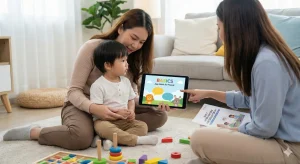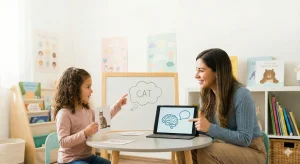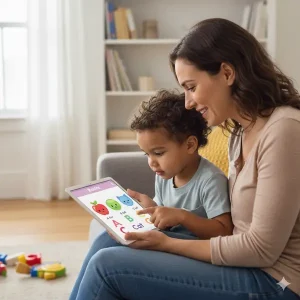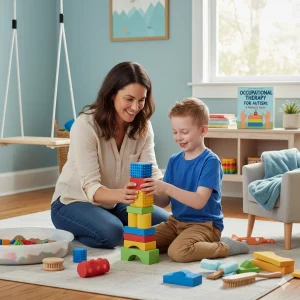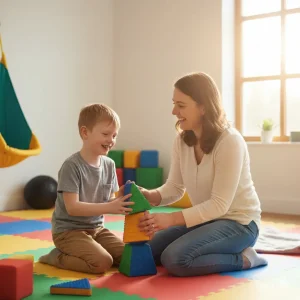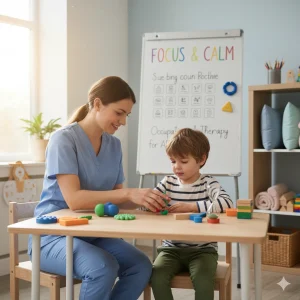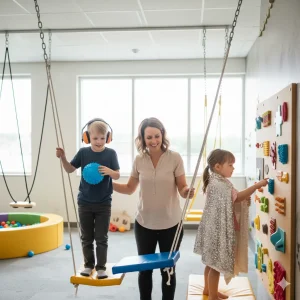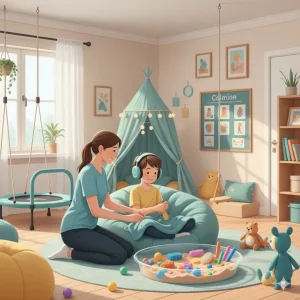Occupational Therapy for 18-Month-Olds: Early Milestone Guide
By Wellness Hub
Last Updated: October 9, 2025
Ever wondered how an 18-month-old’s daily playtime can reveal so much about their developmental journey? At this age, every small action — from stacking blocks to taking those wobbly first steps — is a milestone in the making. But when a toddler isn’t quite reaching those expected markers, early support can make all the difference. That’s where occupational therapy for 18-month-olds steps in.
In this guide, you’ll learn how to spot red flags, understand why early milestones matter, and practice simple OT exercises you can confidently apply in a clinic, classroom, or home setting. These occupational therapy activities for 18-month-olds are practical, evidence-based, and designed to boost fine motor, gross motor, and sensory skills — all while keeping therapy playful and meaningful.
When to Consider Occupational Therapy for an 18-Month-Old
Every child develops at their own pace — some start walking early, others take a little more time. A few may say their first words at 12 months, while others might be quiet observers until 20 months. These small differences are often part of normal development. But sometimes, certain delays or patterns can signal that a child may benefit from occupational therapy at 18 months.
Occupational therapy, often called developmental OT for toddlers, focuses on helping young children build the everyday skills they need to grow, learn, and explore the world confidently. For parents, understanding when to consider early intervention can make a meaningful difference in a child’s developmental journey.
Signs Your Child May Benefit from OT
If your 18-month-old is struggling to meet typical milestones, it doesn’t always mean something is wrong — but it may be a signal to look a little closer. Some signs that may indicate your toddler could benefit from OT include:
- Not showing interest in walking or significant delays in balance and coordination
- Difficulty using their hands for simple tasks like stacking blocks, holding a spoon, or scribbling with a crayon
- Limited interest in exploring their surroundings, avoiding messy play, or becoming easily overwhelmed by textures or noises
- Trouble following simple instructions or participating in everyday routines like dressing or feeding
These early signs are often subtle, and many parents notice them during everyday play or mealtime. Spotting them early allows for timely support through occupational therapy.
What Occupational Therapists Do
A occupational therapist works with children to build skills in areas like fine motor control, gross motor development, sensory processing, and daily self-help routines. For example:
- Strengthening little hands for activities like grasping, feeding, or drawing
- Supporting gross motor skills to improve balance, coordination, and mobility
- Guiding sensory play to help toddlers feel more comfortable with touch, textures, sounds, and movement
- Encouraging independence in early daily routines such as feeding or dressing
The goal is not just to build skills — it’s to help your child participate more confidently in everyday life.
How OT Supports Growth Through Early Intervention
Early intervention can have a powerful impact on a child’s development. At 18 months, a toddler’s brain is highly adaptable, making it the perfect time to strengthen key developmental skills. With the help of occupational therapy, children can:
- Develop stronger motor coordination and sensory awareness
- Build confidence in exploring new experiences and environments
- Learn essential self-care skills, setting the stage for preschool independence
- Improve their ability to focus, follow routines, and regulate emotions
When therapy starts early, it often requires less intensive support later — giving children a smoother developmental path.
Normal Variation vs. Genuine Concern
It’s important to remember: every child is unique. Some delays are simply part of natural variation and resolve on their own with time and encouragement. But if you notice persistent delays, difficulties that affect daily life, or skills that seem to plateau, seeking professional guidance can help rule out concerns and provide clarity.
An early evaluation doesn’t mean your child will “need therapy forever.” In fact, many families find that a few months of structured occupational therapy at 18 months gives their child the boost they need to thrive.
Why These Activities Matter
Gross motor play is about more than burning off energy — it’s about building the foundation for future skills like jumping, running, climbing, and even fine motor tasks. A child with good balance and coordination can participate more easily in play, daily routines, and preschool activities.
By weaving in simple, safe movement experiences at home, parents can support their child’s physical and sensory development in a way that feels fun, natural, and stress-free. If you notice your toddler struggling with balance or avoiding active play, an occupational therapist can help with personalized strategies and exercises.
Tip: Keep sessions short and playful. Toddlers learn best when they’re having fun — not when it feels like “therapy.”
Simple Sensory Activities to Boost Development
Toddlers experience the world through their senses — by touching, smelling, hearing, and moving. These early sensory experiences help build brain connections that support learning, emotional regulation, and motor skills. For many children, sensory play for 18-month-olds is more than fun; it’s a meaningful way to develop attention, confidence, and curiosity.
Sensory OT ideas are often used by pediatric occupational therapists to help children explore textures, sounds, movement, and body awareness in a calm, structured way. These activities are easy for parents to set up at home and can play a big role in supporting your child’s overall development.
Sensory play also benefits proprioception (your child’s sense of where their body is in space) and tactile play (exploring through touch). When toddlers engage in these experiences regularly, they become better at focusing, calming themselves, and joining in everyday activities more confidently.
Sensory Bins with Everyday Items
Sensory bins are one of the simplest and most effective ways to support your toddler’s sensory development. You don’t need expensive toys — everyday household items work wonderfully.
Start with a shallow container and fill it with safe, toddler-friendly materials such as:
- Dry pasta, rice, or beans
- Pom-poms, cotton balls, or sponges
- Water beads (only with close supervision)
- Reusable scoops, cups, and spoons
Let your child explore by scooping, pouring, squeezing, and grabbing. These tactile experiences help them build fine motor strength, hand-eye coordination, and body awareness.
Sensory bins also give toddlers a quiet, calming activity that supports self-regulation — especially helpful during fussy times or transitions.
Bubble Play and Water Play
Few things light up a toddler’s face like bubbles or water play. Activities like blowing bubbles, catching them, or splashing in a small tub of water provide excellent sensory OT input.
- Bubbles encourage toddlers to track movement visually and build coordination as they pop and chase.
- Water play can be as simple as filling a tub with water and adding cups, sponges, and floating toys for pouring and squeezing fun.
This kind of sensory play builds proprioceptive and tactile awareness — helping children understand how their hands, arms, and body move and respond to their environment. It’s also naturally calming and regulating, which can support better attention and smoother daily routines.
Textured Objects & Sand Play
Tactile play is an important way toddlers learn about their world. Offering a variety of textured materials — like soft fabric, spiky sensory balls, wooden toys, or sand — lets your child explore safely and at their own pace.
Sand play, for example, can involve digging, scooping, or pressing hands into soft sand. These movements give children rich proprioceptive input and strengthen their fingers and wrists, preparing them for more complex tasks like drawing or self-feeding.
You can also turn it into a game — hide small toys in a sandbox or sensory tray and encourage your child to find them. This adds an element of focus, attention, and problem-solving to their play.
Why Sensory Activities Matter
Sensory play doesn’t just entertain your toddler — it builds essential developmental foundations. When children get regular sensory input, they learn to regulate their emotions, focus better during tasks, and feel more comfortable exploring new environments.
- Tactile play builds comfort with different textures and improves hand coordination.
- Proprioceptive input helps toddlers understand their body position, making everyday activities like climbing, eating, or dressing smoother.
- Calm, structured sensory experiences can help reduce overwhelm and meltdowns.
These sensory OT ideas are easy, low-cost, and can be part of your daily routine — giving your 18-month-old the stimulation and support they need to thrive.
Tip: Start small, keep it fun, and follow your child’s lead. Sensory play works best when it feels like an adventure, not a chore.
Also read: 8 Fun Sensory Activities for Kids with Autism
Daily Routine Skills and Self-Care OT for Toddlers
One of the most empowering parts of toddlerhood is watching your child begin to do things on their own — whether it’s holding a spoon, sipping from a cup, or trying to put on their shoes. These everyday moments may seem small, but they play a big role in shaping self-care skills in toddlers.
Occupational therapy for daily routines focuses on helping children gain independence in feeding, dressing, and other self-help activities. These skills not only build confidence but also support coordination, problem-solving, and attention — essential abilities for preschool and beyond. With the right guidance, parents can make everyday routines a fun and meaningful part of their child’s development.
Encouraging Self-Feeding with Spoon and Cup
Self-feeding is one of the earliest steps toward independence. At around 18 months, many toddlers are eager to feed themselves but may still struggle with coordination. Encouraging your child to use a spoon and cup regularly can help them:
- Strengthen hand and wrist muscles
- Improve hand-eye coordination
- Develop fine motor precision and control
Start with easy-to-scoop foods like mashed potatoes, yogurt, or soft rice. Use child-friendly spoons with thicker handles to make gripping easier. When introducing open cups, use a small, shallow cup and allow for small sips.
Tip: Expect spills — they’re part of learning! The goal isn’t perfection, it’s giving your toddler the confidence to try again and again.
Simple Dressing and Undressing Practice
Learning to dress and undress is more than just getting ready for the day — it builds your toddler’s independence, fine motor coordination, and sequencing skills (understanding what comes first and next).
Start with simple clothing items like loose shirts, elastic-waist pants, or Velcro shoes. Encourage your toddler to:
- Pull up pants
- Push arms through sleeves
- Take off socks and shoes
- Zip or unzip with your help
Make it playful by turning dressing into a game — for example, racing to put on pajamas or singing a “getting dressed” song. Practicing these skills daily creates a natural daily OT routine that fits right into your child’s life.
Play-Based Strategies to Build Independence
Children learn best through play. That’s why play-based strategies are at the heart of most pediatric OT programs. Instead of drilling skills, you can make daily routines feel like fun:
- Let your toddler pretend to feed a doll or teddy bear with a spoon — this builds motor planning and confidence.
- Use dress-up games with hats, scarves, or simple costumes to encourage putting on and taking off clothes.
- Set up a small “independence station” at home with accessible spoons, cups, or clothing items so they can try on their own.
These playful moments help toddlers feel in control, turning daily routines into confidence-building opportunities rather than chores.
Why Daily Routine Skills Matter
Developing self-care skills in toddlers is about more than just convenience — it’s about nurturing their growing sense of independence and self-worth.
- Self-feeding builds fine motor control, coordination, and confidence.
- Dressing skills encourage sequencing, motor planning, and problem-solving.
- Play-based strategies make learning natural, engaging, and enjoyable.
By weaving these activities into everyday life, parents can give their children a strong foundation for independence, making the transition to preschool smoother and more successful. If your toddler struggles with daily tasks, an occupational therapist can provide tailored strategies to support progress at their own pace.
Remember: Independence grows best through patience, repetition, and encouragement — not perfection.
When to Seek Professional Help — Early Intervention Matters
Every child grows and learns in their own unique way. Some may start walking early, others may take a little longer to find their balance. Some might chatter nonstop by 18 months, while others are quieter observers. A little variation is completely normal. But knowing the difference between what’s typical and what may need evaluation can make a powerful difference in your child’s developmental journey.
Spotting red flags at 18 months early and seeking guidance promptly can help your toddler get the right support at the right time. That’s exactly where occupational therapy and early intervention come in — not to label your child, but to give them the best chance to thrive.
What’s Typical vs. What Needs Evaluation
By 18 months, most toddlers are able to walk, use simple gestures like pointing, say a few words, and show curiosity about their surroundings. But if your child:
- Isn’t walking or shows poor balance and coordination
- Doesn’t point, wave, or respond to their name
- Avoids exploring textures or new environments
- Has difficulty holding or manipulating objects
- Shows little interest in play or interaction
It may be time to look a little closer. These can be early signs that your child might benefit from developmental support. Remember, noticing delays is not about comparison — it’s about making sure your child gets the help they need, when they need it.
Who to Talk to: Pediatrician & Pediatric OT
If you’ve noticed some of these signs, your first step should be talking to your pediatrician. They can help determine whether your child’s development falls within a normal range or if further assessment is needed.
A pediatric occupational therapist (OT) can evaluate specific areas like:
- Fine and gross motor skills
- Sensory processing abilities
- Self-care and play skills
- Daily routines and participation in activities
Together, your pediatrician and OT can create a personalized plan to address your child’s unique needs. The goal isn’t to “fix” your child but to equip them with the skills and support they need to reach their full potential.
Early OT Leads to Better Long-Term Outcomes
One of the biggest advantages of occupational therapy early intervention is that it works with your child’s natural developmental window — a time when their brain is highly adaptable. When support starts early:
- Developmental skills are strengthened more effectively
- Delays are often minimized or caught up faster
- Children build confidence and independence
- Parents learn practical strategies to support growth at home
Early intervention doesn’t mean there’s something “wrong” with your child. It means you’re giving them a head start, setting a strong foundation for learning, communication, and everyday life skills.
Tip for parents: Trust your instincts. If something feels off, even slightly, it’s okay to ask questions. Reaching out early is never a mistake — but waiting too long can make progress more challenging.
Conclusion
At 18 months, your child is learning through play, touch, and daily routines. Simple occupational therapy exercises for 18 months—like climbing on cushions, peeling stickers, or water play—can build fine motor skills, balance, and independence. Early developmental OT for toddlers helps boost confidence and supports healthy growth.
Be proactive, not pressured—every small step matters. You can start with a simple OT home program, download free activity worksheets, or talk to a pediatric OT for extra support. Early help is powerful, and playful learning creates strong foundations for your child’s future.
Frequently Asked Questions:
1. What are typical milestones for an 18-month-old?
Most toddlers at 18 months can walk steadily, say a few simple words, follow basic instructions, and explore their surroundings. They may stack blocks, point to objects, or feed themselves with help. These are general milestones — some children may reach them earlier or later. If your child is taking a bit more time, it’s not always a cause for worry.
2. When should I consider occupational therapy for my 18-month-old?
You might consider OT if your child isn’t showing key developmental skills like walking, exploring, or using simple words. Occupational therapy helps toddlers build movement, coordination, and daily living skills. Early support can help them reach milestones more smoothly and confidently.
3. What does occupational therapy for an 18-month-old include?
Occupational therapy for toddlers focuses on everyday skills like movement, play, and self-care. Sessions may include fine motor activities, sensory play, balance exercises, and practical tasks like spoon feeding or dressing. The goal is to help your child become more independent through fun, age-appropriate activities.
4. Can I do occupational therapy exercises at home?
Yes, parents can play a big role in supporting development. Activities like sticker peeling, bead stacking, obstacle courses, and water play are simple OT home exercises you can do daily. These help your toddler strengthen their hands, improve coordination, and build confidence in a playful way.
5. What are red flags at 18 months I should not ignore?
Some signs to look out for include not walking yet, no meaningful words, not responding to their name, avoiding touch or textures, or showing no interest in play. These don’t always mean something is wrong — but they can be early red flags at 18 months that may need further evaluation.
6. How can sensory play help my toddler’s development?
Sensory play — like touching different textures, playing with sand, water, or bubbles — builds body awareness, attention, and coordination. It also helps children learn to process sensory input calmly. Regular sensory play can reduce meltdowns, improve focus, and make daily routines easier for both child and parent.
7. How does OT help with self-care skills?
Occupational therapy encourages toddlers to learn everyday skills like self-feeding with a spoon, drinking from a cup, and putting on simple clothes. These skills build independence and fine motor strength. Learning these routines early makes daily life smoother for families and boosts your child’s confidence.
8. Is early occupational therapy effective for toddlers?
Yes. Early occupational therapy intervention is very effective because a toddler’s brain develops quickly at this age. Early support can help children catch up on milestones, build stronger skills, and reduce future developmental challenges. It’s not about “fixing” your child — it’s about supporting their growth.
9. Do I need a doctor’s referral for occupational therapy?
In many areas, parents can contact a pediatric OT directly, but it’s always wise to talk to your pediatrician first. They can guide you, offer referrals, or help rule out any underlying medical concerns. Early evaluation can bring peace of mind and a clear plan forward.
10. Where can I find OT exercises and plans for my toddler?
You can access free OT worksheets, activity guides, and simple OT home programs online. These help you create fun, structured play routines. If you want personalized support, booking a consultation with a pediatric occupational therapist can give you a step-by-step plan tailored to your child’s needs.
About Author:
Sonali Sharma, Occupational Therapist
Sonali Sharma is a skilled Occupational Therapist at Wellness Hub, with over three years of experience in supporting children with developmental, behavioral, and learning challenges. She holds a Bachelor’s in Occupational Therapy (BOT) from Amity University and has worked with leading institutions such as NIMHANS Bengaluru and ESIC Hospital Faridabad.
At Wellness Hub, Sonali provides online occupational therapy sessions tailored to each child’s needs. She specializes in pediatric therapy, autism support, sensory integration, and developmental skill-building, helping children strengthen motor skills, improve focus, and become more independent in daily life.
Her therapy style is child-centered, play-based, and evidence-driven—making sessions both effective and enjoyable for kids. Sonali also equips parents with practical home therapy strategies to extend progress beyond sessions.
Passionate about empowering families, Sonali believes in creating a nurturing space where children can thrive while parents feel supported every step of the way.
Book your Free Consultation Today
Parent/Caregiver Info:
Client’s Details:
* Error Message
